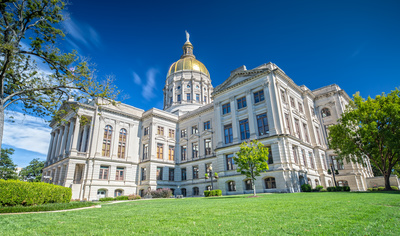
Elections & Campaigns, Energy & Environment
Nine States Face Key Public Utility Commission Elections Ahead of 2026
October 27, 2025 | Billy Culleton
April 27, 2022 | Ben Fallick
-f50a6d-1200px.jpeg)
Key Takeaways:
Extended producer responsibility (EPR) is a somewhat amorphous term but is generally described as a policy intended to involve producers in waste reduction. In EPR programs, producers of a product must develop programs to dispose of the waste created by that product at the end of the product’s life cycle, often paying for processing the waste produced. In many programs, producers track the product’s life cycle to ensure they can easily and safely destroy or reuse the product. Currently, thirty-two states have created producer responsibility laws specific to individual product categories or packaging material. Most laws focus on difficult-to-recycle products like electronic devices, paint, mattresses, or batteries.
Today, states are looking to apply the EPR concept beyond individual product categories to all types of packaging material to attempt to reduce waste. Prior to 2021, packaging had never been targeted by law as a product subject to an EPR program. However, the recycling industry currently faces many challenges, including the need for more consumer education, current recycling infrastructure that cannot meet capacity, limitations on export waste, and inconsistent measurement of recycling methodologies. Many states can no longer export their waste to other countries and instead must grapple with disposing of their waste locally. Packaging EPR programs hope to stabilize the system through producer involvement.
Last year, Maine and Oregon became the first two states to enact packaging EPR laws. Both laws use funds generated from packaging producers to expand the state’s municipal recycling systems. Companies must fund a packaging stewardship organization, which manages the system.
Under Maine’s law (ME LD 1541), a packaging stewardship organization (PSO) will control producer waste recycling, and all companies that produce packaging waste in the state will pay into the PSO. The law defines a “producer” as the “legal owner of a brand of a product sold, offered for sale, or distributed for sale in or into the state which is contained, protected, delivered, presented, or distributed in or using packaging material.” A producer is also defined as “a person that imports into the state for sale, offered for sale, or distributed for sale a product that is contained, protected, delivered, or distributed in or using packaging material that is branded by a legal owner.” Companies will pay a specified rate based on the quantity and type of packaging brought into the state. Maine’s law provides for only one PSO to conduct recycling efforts.
In Oregon, the packaging EPR law (OR SB 582) will require companies to join a producer responsibility organization (PRO) and pay annual fees to the PRO based on environmental impact. Funding raised from this program will be used to upgrade recycling facilities. The state will specify what materials will be recyclable but exclude beverage containers. In Oregon, multiple PROs may be created, which some view as adding another layer of complexity to the program.
Neither Oregon nor Maine are in a rush to implement these new laws. The rulemaking processes in both states have a long road ahead. Maine plans to conclude the stakeholder input process by the end of 2023, with final adoption slated for 2025, and the establishment of the stewardship organization scheduled for 2026. Oregon’s process is slightly faster and requires the PRO to be up and running by 2025.
Due to the lack of federal interest on this issue, state governments will continue to debate packaging EPR programs as a way to augment and fund their recycling infrastructure. State legislatures are developing various programs that will eventually create a patchwork of rules and cause compliance concerns for companies with multi-state footprints. Some proposals put the onus on producers to create and control the program, giving them a larger say over how the system will run. Other programs shift the controlling responsibility towards municipalities, who in turn reimburse local recycling programs for costs associated with packaging waste with funding from corporations.
Currently, lawmakers in 17 states are debating packaging EPR this session (see map below). Notably, California voters are likely to see a ballot measure that levies a fee on single use plastic packaging this November, while the Colorado Department of Public Health and Environment has conducted prior research on packaging EPR.

In California, EPR legislation (CA SB 54) passed the Senate earlier this year and is awaiting action in the Assembly. The bill stipulates that businesses in California have the responsibility to pay for the cost associated with the recovery of materials they sell in the state. While the bill would not specifically create an organizational structure or financial requirements, it would establish a base to build on in the future. As mentioned, California voters will decide whether to adopt a ballot measure this fall aimed at reducing packaging waste. While much of this initiative is dedicated to banning single-use plastics, a portion of the measure’s language generates revenue from producers that manufacture single-use plastics. These fees would be distributed to local governments, CalRecycle, and the California Natural Resources Agency. Both of these plans in California differ from the programs in Maine and Oregon, showcasing the different avenues for packaging EPR programs and furthering compliance concerns.
In Colorado, the state’s Department of Public Health and Environment has been studying EPR in depth since last year. Colorado lawmakers are debating several pieces of legislation that would establish packaging EPR programs. The first (CO HB 1159) would create the Circular Economy Development Center to find new avenues in recycling infrastructure and create a sustainable circular economy for recycled commodities. To pay for this program, the Front Range Waste Diversion Enterprise, an existing program providing grants and assistance to communities in Colorado’s Front Range, would use their cash fund. A second bill (CO HB 1355) stipulates that the executive director of the Colorado Department of Public Health and Environment must designate a nonprofit organization to implement and manage a statewide program that provides recycling services to covered entities. Covered entities include residences, businesses, schools, government buildings, and public places.
While there has been no collaboration between states on packaging EPR so far, there is potential for states leaders and industry experts to collaborate and create systems of interstate packaging EPR management. There is wide variety in how states are approaching packaging EPR legislation and harmonization will be key to effective and efficient recycling programs in any region across the country. The Institute for State Policy Leaders has plans to convene interested legislators and industry experts this summer in an effort to explore best practices in this complex policy space.

October 27, 2025 | Billy Culleton

August 13, 2025 | Bill Kramer

July 8, 2025 | David Shonerd